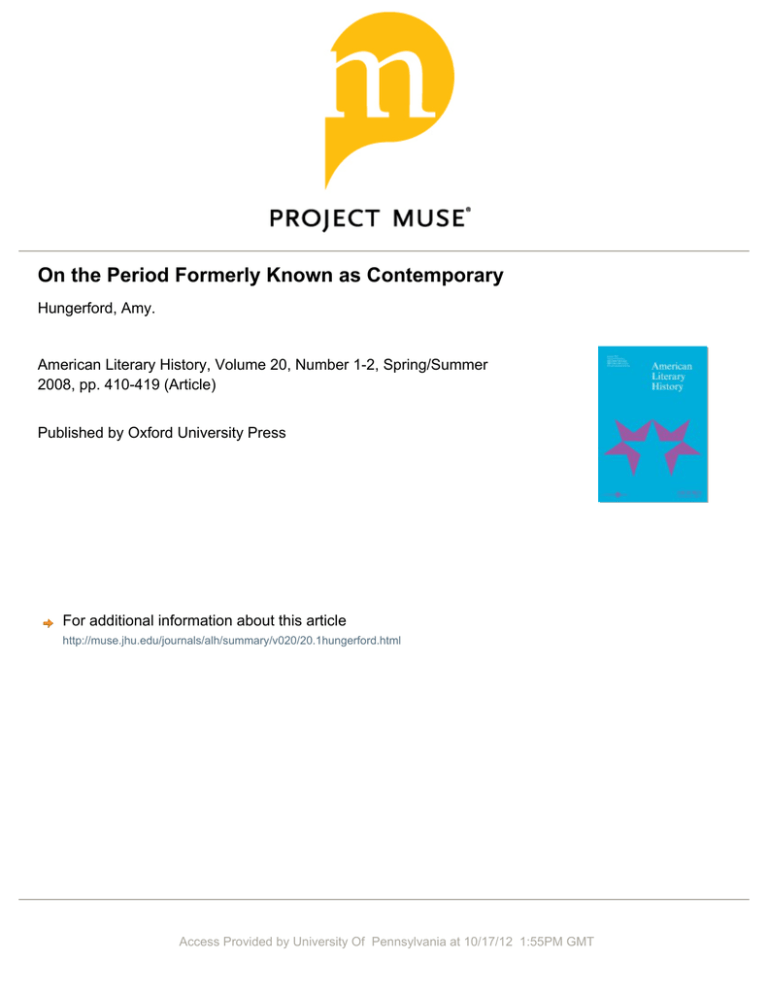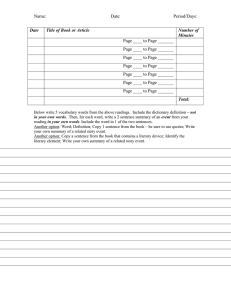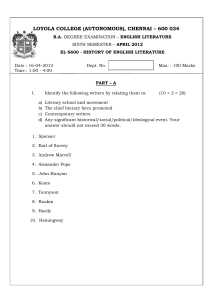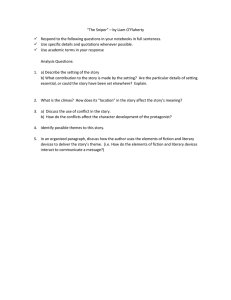
On the Period Formerly Known as Contemporary
Hungerford, Amy.
American Literary History, Volume 20, Number 1-2, Spring/Summer
2008, pp. 410-419 (Article)
Published by Oxford University Press
For additional information about this article
http://muse.jhu.edu/journals/alh/summary/v020/20.1hungerford.html
Access Provided by University Of Pennsylvania at 10/17/12 1:55PM GMT
On the Period Formerly
Known as Contemporary
Amy Hungerford
1989, the year of American Literary History’s founding, held
out a tantalizing moment for periodizers of whatever comes after
modernism. The fall of the Berlin Wall, the break-up of the Soviet
Union, and the end of the Cold War seemed to tell us that we had
arrived at a moment of genuine historical transformation. Francis
Fukuyama declared the end of history shortly after, in 1992, and it
would seem to follow naturally that the post-45 era was coming to
a close. But if this was true in the realm of global politics, it was
less apparent in literature and the arts more generally. Political
watersheds are one thing, but cultural or aesthetic ones quite
another, and it was not immediately clear—nor is it clear now—
that, to borrow a turn of phrase from Virginia Woolf, literature
changed, even if the world did, on or about 9 November 1989.
One could argue that 1989 launched us into the age of multiculturalism, or, more negatively, sectarianism. The culture wars were
already warming up in the US: Allan Bloom’s The Closing of the
American Mind and E. D. Hirsch’s Cultural Literacy: What Every
American Needs to Know were published in 1987; Toni
Morrison’s Playing in the Dark: Whiteness and the Literary
Imagination, one of the more lasting documents to come out of the
culture wars, was published in 1992. 1992 also saw the start of the
Bosnian War, the most dramatic example of resurgent sectarian
strife in Eastern Europe after the fall of the Soviet Union. On the
American literary scene, pluralism defined the moment; in the
international scene, sectarianism; in both cases, identities seemed
to be at stake. But if, in Bosnia, your identity could get you killed,
in America, it seemed, your identity could get you published.
In keeping with the largely happy outcomes of multiculturalism in literature and in the classroom, by the end of the century
Amy Hungerford is Professor of English at Yale University. She is the author of
The Holocaust of Texts: Genocide, Literature, and Personification (2003), and is
completing a study of religion and literature entitled “Postmodern Belief:
American Literature and Religion Since 1960.”
doi:10.1093/alh/ajm044
Advance Access publication November 16, 2007
# The Author 2007. Published by Oxford University Press. All rights reserved.
For permissions, please e-mail: journals.permissions@oxfordjournals.org
American Literary History
scholars of the period since 1945 had the pleasure of a vastly
expanded canon, a wealth of well-crafted novels from relatively
unknown writers to consider, a few major careers to account for,
and the task of defining the second half of the twentieth century
ahead of them. Wendy Steiner, in her section of The Cambridge
History of American Literature, volume 7 (1999) (“Postmodern
Fictions, 1970 to 1990”), quite elegantly represents the position in
which the next generation of scholars of this literature found themselves as they defended their dissertations in the closing years of
the twentieth century. She showed how a reading of experimentalist novels can be—and, indeed, must be—integrated with a discussion of realist writing. She thus set herself the task of undoing the
reigning bifurcation of contemporary fiction into the “postmodern”
avant-garde and the writing of women and people of color that
was so often dismissed, in the academy, as naively realist or
concerned more with social issues than with the development of
literary aesthetics.
In this sense, Steiner was informed by the culture wars of the
1990s, but not shackled by them. Her account of what would then
have been labeled as contemporary fiction crystallized an emerging
critical consensus that the categories produced both by the literary
press and by the academic disputes over the canon produced, at
best, a misleading opposition between these two kinds of writing.
At worst, that opposition suggested a hierarchy of value in which
the writing of mainly white male authors such as Thomas
Pynchon, John Barth, William Gaddis, and Don DeLillo was
deemed “literary” whereas the work of writers such as Toni
Morrison, Philip Roth, Louise Erdrich, Leslie Marmon Silko,
Alice Walker, and Joan Didion was thought to be mainly concerned with the sociological aspects of fiction. This bifurcation of
value, a legacy of New Criticism’s investment in modernist difficulty, was one of the primary ways that modernist understandings
of the literary stretched beyond the moment of high modernist aesthetic production. The way Steiner mixes up the categories—by
pointing out, for example, the literary self-consciousness on
display in Erdrich’s Love Medicine (1993), the significance of
Oedipa Maas as a housewife in Pynchon’s Crying of Lot 49
(1966), or the way Joseph Heller’s Catch-22 (1961) came to seem
like a realist novel in the age of Vietnam—has become, since the
late 1990s, the standard practice among critics working in the
field. Whether that takes the form of rising interest in writers such
as Ishmael Reed and John Edgar Wideman, whose clearly political
and identitarian commitments are combined with an exuberant
experimental quality in their fiction, or the emergence of studies
such as Rei Terrada’s Feeling in Theory (2001), which reveals the
411
412
On the Period Formerly Known as Contemporary
sentimental underside of the most esoteric avant-garde theory of
the late twentieth century, literary studies in this period sought to
abandon the rigid divide between the so-called “postmodern” and
“ethnic” or “women’s” literature. John Barth’s famous stigmatization of the latter as “secular news reports” in his 1967 essay, “The
Literature of Exhaustion,” had lost its purchase by the turn of the
millennium. Not incidentally, its author’s novels had lost a good
deal of their purchase on readers as well.
The effort to move beyond ever more divided accounts of the
post-1945 period in American literature was thus well begun in
Steiner’s essay, even if it was not the main analytical aim of its
argument. Morris Dickstein, in the same volume, used an attentive
historicism to build bridges between novels of the 1940s and
1950s that are generally thought to be aesthetically quite distinct.
He showed, for example, how novels as stylistically divergent as
Lolita (1955) and On the Road (1951) confront similar American
realities. But despite these local integrations, the purpose of the
1999 Cambridge History volume in toto was, as its editor Sacvan
Bercovitch explained in his introduction, to maintain multivocality,
to emphasize difference, and to reproduce in the volume’s critical
accounts the oppositional times in which the fiction in question
was written. This commitment is reflected in the way writing by
women, people of color, gay and lesbian writers, and even regional
writing, is separated out by chapter and section within the volume.
At the same time, two sections of the book—on drama and on
southern writers—seem to reflect a continuing interest in canon as
traditionally understood, devoting a chapter to each writer among
a small group of those already considered important by the literary
press. Less magisterial surveys—such as the very short
Bedford-St. Martin’s paperback on The Twentieth-Century Novel
(1997), or the post-1945 chapters within the single-volume
Columbia Literary History of the United States (1988)—produce
similar structures and contradictions on a smaller scale, citing
some works by women and writers of color in discussions of
“postmodernism” but then devoting separate sections to
African-American, gay and lesbian, and feminist literature and
theory, or to stylistic categories like realism and self-reflexive
fiction.
If this revisionary work was just settling into place at the
core of post-45 literary studies by the turn of the century, where
are we now? One answer can be found in Mark McGurl’s recent
take on the Steiner-style mixing-up effort. In his essay, “The
Program Era: Pluralisms of Postwar American Fiction” (2005),
McGurl argues that the fiction of the postmodern white guys imagines itself finally in terms fully assimilable to the identitarian
American Literary History
ethos of ethnic fiction. This results in a convergence of what
McGurl calls “high cultural pluralism” and “technomodernism”
(106), such that “even the whitest-seeming technomodernism can
funtion as a discourse of difference” (120), and the writing tagged
as ethnic fully assimilates the self-reflexive interests of literary
modernism. The university, which McGurl both reads out of the
period’s fiction (as in John Barth’s campus computer in Giles
Goatboy [1966]) and returns to as the institutional site of
American literary work since the 1950s, becomes the training
ground for both readers and writers. There, high-culture modernism and its assumptions about reading and about literature are
bequeathed to post-war generations of students, and studentwriters, by the New Criticism. This is how modernism, on
McGurl’s account, ramifies throughout the niche fiction of the
post-1960s literary marketplace. The essay I am paraphrasing here
is part of McGurl’s broader argument about the period, that it is
defined by the historically novel situation of the writer within the
university.
If McGurl thus extends the work that Steiner and others were
beginning to do at the close of the century, he also neatly, and
I think productively, sidesteps the cultural materialist accounts of
postmodernism that have been so powerful in defining the field—
specifically, Fredric Jameson’s argument about the relationship
between culture and late capitalism in Postmodernism (1991).
McGurl finds the specific sociological conditions of production
and consumption of literature—their location in the university—
the relevant context through which to understand aesthetic transformations (and, more centrally, continuities) of American fiction
in the second half of the century. His guides here are John
Guillory, Bill Readings, and (implicitly) Pierre Bourdieu. Indeed,
cultural materialist arguments in other fields, such as Mark
C. Taylor’s account of postmodern religion in Confidence Games:
Money and Markets in a World Without Redemption (2004), often
weakens when it turns to the literary. Like Jameson in
Postmodernism, Taylor locates the moment of postmodernism not
in the fall of the Berlin Wall or at the close of the century, but on
16 August 1971, when global finance ceased to be tied to the gold
standard, but this exacting historicism undermines itself the
moment novels are invoked. Taylor’s first two examples of the
postmodern faith that is his subject are William Gaddis’s 1955 The
Recognitions and Herman Melville’s 1857 The Confidence-Man:
His Masquerade, suggesting that the literary embodiment of what
he defines as the condition of postmodernism cannot be neatly
linked to genuinely transformative moments in the market. The
connection works by analogy rather than by causation, which is
413
414
On the Period Formerly Known as Contemporary
why McGurl’s more rigorously historical argument—which in
pointing to the university classroom can account for precisely how
the aesthetic inventory of modernism could be disseminated to the
American pluralist market—seems to me more convincing.
The status of irony has also come under significant revision
since the millennium, and since the philosophical apotheosis of
irony in Richard Rorty’s 1989 Contingency, Irony, and Solidarity.
I am thinking here, for example, of Debbie Nelson’s recent work
on the representation of affect and sincerity in Hannah Arendt,
Mary McCarthy, and Joan Didion.1 In a more theoretical vein, we
might also point to the transformation of Walter Benn Michaels’s
career between the late 1970s and the early years of the new
century: an early and influential critic of theory, he became even
more controversial during the culture wars when he published Our
America (1997), in which he deconstructs the idea of race as a cultural construction. He then combined the two enterprises in The
Shape of the Signifier: 1967 to the End of History (2004), a book
that connects the vogue for irony in the period with the reigning
accounts of culture and identity. The burden of his analysis is to
argue that we mean what we say, that who we are has nothing to
do with the meaning of what we say, and that to think of disagreement in terms of difference is finally to embrace the logic both of
terrorism and of biological essentialism.
In my own work, attending to religion in literature of this
period has allowed me to see how the rise of sincerity over irony
as a literary mode reflects and enables a peculiar belief in meaninglessness in American religious life. The writers I examine see
fracture and materialism not as ends in themselves but as the conditions for transcendence, see the postmodern worry about truthclaims as the avenue to resurgent supernaturalism. Don DeLillo’s
work provides a signal example of these shifting qualities of late
twentieth-century literature: the ironic, playful White Noise (1985), a
standard text of the old postmodernism, now seems an aberration
within DeLillo’s oeuvre—or it is read to emphasize characters such
as the child, Wilder, who represent what more than one critic has
called a Romantic sensibility in DeLillo’s work. Underworld (1997)
and The Names (1982), both of which are ambitious and only locally
ironic, now seem more accurately to define his literary project. The
unbelieving nuns who tend Mr. Grey’s gunshot wounds in White
Noise are just one more satirical joke in secular white suburbia, but
in Underworld, Sister Edgar’s embrace of a mystical vision in the
multiethnic Bronx is rewarded with a very Catholic-looking afterlife
on the internet. My reading of DeLillo as a religious writer,
informed by the transformations of Roman Catholicism during the
Vatican II era, grounds the changing assessment of his work in the
American Literary History
history of America’s peculiar religiosity.2 In DeLillo’s case, one
begins to see how the shifting status of irony becomes palpable in
the changing understanding of major fictional careers.
DeLillo’s vision of the internet in Underworld marks another
transformation we are still in the midst of. The geekdom of computers, which, via Pynchon and Barth, provided the aura of what
we thought of as postmodern fiction, is no longer for geeks only.
Hypertext novels seemed for a moment an important point of
contact between technology and literature; now they look archaic
from a technological point of view and irrelevant from a cultural
point of view. Far more central, I think, is the simple fact that new
forms of reading and writing are emerging on a vast scale. Though
YouTube may eventually make video as central to the web as
writing is, I doubt it will replace writing in that realm, as the
success of blogging suggests ( just as video has not, as feared,
entirely replaced writing outside the virtual world). So far the
most serious attempt to come to grips with what these advances
mean for literature—or more ambitiously, for language—is
Katherine Hayles’s work on the posthuman, and on code. Though
I am not convinced by her argument in My Mother Was a
Computer: Digital Subjects and Literary Texts (2005) that the
structures of code itself are changing language, it is undeniable
that the imaginative structures of software interfaces—from our
metaphorically-named desktops to vast web-based collaborative
games—inform both the logic and the imagination embodied in
the endlessly ramifying internet. The problems of archiving raised
by, for example, the Google book project and the Internet
Archive’s Wayback Machine, with its “snapshots” of the internet
that can be studied by historians as old newspapers are, suggest
the vastness of the changes in book culture, and in the culture of
reading, writing, and scholarship, that are yet—but soon—to
come. Insofar as literary scholarship aims to have something to
say about reading and language in general—insofar as it embraces
the idea that we should ideally be able to speak to the general
reader, and that we are more than curators of a relatively narrow
sample of cultural production and the writers of its history—the
scholars who study the late twentieth century and beyond will
have to engage the forms of writing found in virtual space, either
as literary artifacts in themselves, or as the penumbra of writing
that surrounds the literary object.
At the end of the century, ALH, in publishing a special issue
titled “American Writing 1999,” proclaimed the need to focus on
the relationship between living writers and the reviewers and scholars who routinely respond to them—which is to say, the readers
writers must contend with beyond the “passionate few” lay readers
415
416
On the Period Formerly Known as Contemporary
they most covet. The scholars, both in the view of writers and of
critics such as Mary Poovey, who wrote for the special issue, were
still hamstrung by a disabling commitment to theory, where theory
and its jargon represented the high-status niche of the profession
while writing—especially composition, or, in the literary realm,
mere reviewing or old-fashioned close reading—occupied the low
status. What has changed since then is the solid dominance of historicism. It was already in play by the time Representations started
up in 1983, but it now seems less a critical movement than a
simple assumption about literary-critical work, more widespread
than any point of view that could be said to be strictly theoretical.
A student of mine at Yale, writing what I think will be a brilliant
book about the autonomy of the work of art in modernism—a
New Critical or deconstructive take on the literary if there ever
was one—seeks to historicize precisely that fantasy—a fantasy
toward which he is nevertheless deeply sympathetic. This student’s
approach represents not a wave but a tide, or even just the water
we all swim in: close reading remains at the heart of our critical
practice—and, as McGurl argues, is installed at the heart of creative practice, too. However, the uses of those readings are broad
among the rising generation of post-1945 literary scholars: from a
Marxist-inflected argument such as Andrew Hoberek’s The
Twilight of the Middle Class: Post-World War II American Fiction
and White-Collar Work (2005), to Rachel Adams’s work on the literature of the Americas ( part of the new transnational approach to
literary study), to the work of Sean McCann or Michael Szalay on
literature and politics since the 1950s, to my own culturally historical work on genocide and religion as they intersect with literature.
Another way of registering where we are now is to cite the
founding, in the fall of 2006, of Post†45, a collective of scholars
mainly just finishing first books or in the middle of second books.3
What emerged at the group’s initial symposium was the growing
edge of scholarly work in the field formerly known as contemporary, produced by a new generation of scholars born at or after the
end of the 1960s. For this generation, the 1960s are history, not
memory—an advantage when it comes to the business of
historicizing—and the politics of the 1960s are less a nostalgic
ideal than an ambivalent example of what happens when institutional politics turns into cultural politics. Some of us work in the
wake of our disillusion with multiculturalism, some in the hope of
bringing a related agenda of inclusiveness further along with a
more complex conception of what can be done with such an
approach. Jonathan Freedman’s writing on Asian-American and
Jewish cultural interfaces was one example of this constellation of
concerns at the 2006 conference; it was also evident in the
American Literary History
globalizing work of Brian Edwards, Andy Hoberek, and Rachel
Adams, for whom the history and ends of cultural permeability
take on a less simply smug, or (on the other side) demonized cast.
The arrival of Western cultural artifacts in Iran, for example, is not
for Edwards a cause for celebration or a moment of lament, but
simply the site of another creative engagement to be thought
about.
Interdisciplinarity has also transformed since this rising generation was in graduate school; then, with theory at or just rounding its peak, English was an export discipline, with semiotic
analysis entering history and political theory through the work of
Michel Foucault and Hayden White. Now English is importing,
though again, in a way that honors the enduring value literary
study places on close reading: Post†45 began with a proposed
session for the Modernist Studies Association meeting on the
intersection of literature and sociology at mid-century. We read the
session’s rejection as the signal that modernism was not what we
were talking about, or at least, that if it were, then we needed a
different context in which to define what modernism looks like in
the mid- and late twentieth century. The seminar ran at the
ensuing Post†45 conference with six participants presenting work,
and what emerged was a remarkable set of common texts and
writers, along with strongly debated issues arising from these.
A room in which more than half the people in it have read Lionel
Trilling’s 1947 novel, The Middle of the Journey, is rare; even
rarer is a room whose occupants can also speak knowlegably
about the work of William H. Whyte, Ann Petry (The Street
[1946] was a common text), and Joan Didion. It is worth saying
that the conference simply invited participants to present work in
progress, rather than defining topics or authors to organize the
papers. The convergence was part of the surprise rather than the
programmatic aim. Other versions of interdisciplinarity on display
in the 2006 meeting included J. D. Connor’s work on game theory
and film, Sara Blair’s on Richard Wright’s photography, Abigail
Cheever’s on identity and the medicalization of personality, and
Deak Nabers’s on law and the literary logic of race.
In his response to a version of this paper given at an ALH
symposium in the spring of 2007, Gordon Hutner told a story
about deciding whether to take “Contemporary American Fiction”
at Kenyon College in 1970—a year-long course that would not,
however, be counted toward the English major. He suggests:
The thinking was that the contemporary was, in a word, too
easy, since it did not pose the same sorts of problems as
reading Troilus and Criseyde or Astrophel and Stella did. . . .
417
418
On the Period Formerly Known as Contemporary
The assumption went, and in large part still goes, that once
students got their mettle tested with Milton and Melville,
they should be able to distinguish what’s good and bad in
contemporary writing for themselves. Or, more sympathetically, . . . that scholars and literary historians simply did not
know yet what contemporary writing would prove interesting
to the future and what was merely ephemeral.
Perhaps it would be
better to call this period
long modernism, in
keeping with [the]
sense . . . that the second
half of the twentieth
century sees not a
departure from
modernism’s aesthetic
but its triumph in the
institution of the
university and in the
literary culture more
generally.
This is changing, and quickly, thanks to the work of a new generation of critics in the field, critics who are not confined to those
hefty postmodern slabs that formerly sat on syllabi as proof of the
difficulty, and thus the worth, of contemporary writing in the
academy.4
Still, even at Post†45, some evinced discomfort at writing
about the literature of the late century even if we do now teach it
with greater confidence, suggesting once again that focal distance
may finally be necessary in order to see the past clearly, something
historians have long known. Tyler Curtain recently pointed out to
me that perhaps it would be worth conserving “contemporary” as
the name for the period that began somewhere around the middle
of the twentieth century and which we still, probably, inhabit.
Post-45, a term I have favored, implies a minimal set of assumptions about the ways the world and culture—especially American
culture—changed since the end of World War II. But even those
assumptions are under debate, and perhaps the debate is useful.
Perhaps it would be better to call this period long modernism, in
keeping with McGurl’s sense, and my own, that the second half of
the twentieth century sees not a departure from modernism’s aesthetic but its triumph in the institution of the university and in the
literary culture more generally. But finally, how interesting are the
arguments about how to choose beginnings and ends? More interesting is all the new work being done with the cultural artifacts of
the last six or seven decades. It is enough to make me follow the
pop singer Prince’s example, to which my title alludes, to give up
the hieroglyphics we have nominated for the header of this period
and concede that until the contemporary is over, I will call myself
a scholar of contemporary literature.
Notes
1. See Deborah Nelson, “The Virtues of Heartlessness: Mary McCarthy,
Hannah Arendt, and the Anesthetics of Empathy,” American Literary History
18:1 (2006): 86– 101; on Didion, I refer to the in-progress essay she presented at
the 2006 Post†45 conference, “The Question of Self-Pity: Style, Feeling, and
Morality in Joan Didion.”
American Literary History
2. See Hungerford, “Don DeLillo’s Latin Mass,” Contemporary Literature 47.3
(2006): 343 –80.
3. The collective’s first symposium, held on 27 –28 October 2006 at Concordia
University in Montreal, was titled “Mid-century to Postmodern: The Post-War
Era Reconsidered,” and the association was, for the purposes of that conference,
called the Postmodern Studies Association. At the conclusion of the two days, the
group renamed itself Post†45 and agreed to sponsor yearly meetings to discuss
the pre-circulated work-in-progress of rising scholars in the field. The participants
in the 2006 conference were Rachel Adams, J. D. Connor, Sara Blair, Abigail
Cheever, Brian Edwards, Mary Esteve, Jonathan Freedman, Andrew Hoberek,
Amy Hungerford, Sean McCann, Deak Nabers, Deborah Nelson, and Michael
Szalay. The 2007 conference was held in October at Harvard, hosted by
J. D. Connor; the 2008 conference will be held at Yale, hosted by Amy
Hungerford.
4. Upon arriving at Yale in 1999, I felt this residual prejudice emanating as
much from our elite students as from the structures of our undergraduate curriculum (though students did get major credit for studying contemporary literature). It
was not until recently that I felt confident enough in my professorial gravitas to
offer, as a lecture course, a post-45 novels course that I touted primarily as a
course for fun reading. One student complained that it did not live up to the
billing because of novels like The Crying of Lot 49 (1966) and Blood Meridian
(1985); if these were the objectionable novels, then I felt I had done my job balancing pleasure with pain.
Works Cited
Dickstein, Morris. “Fiction and
Society: 1940–1970.” Cambridge
History of American Literature. Ed.
Sacvan Bercovitch. Vol. 7.
New York: Cambridge UP, 1999.
101 –310.
McGurl, Mark. “The Program Era:
Pluralisms of Postwar American
Fiction.” Critical Inquiry 32.1 (2005):
102 –29.
Steiner, Wendy. “Postmodern
Fictions, 1970– 1990.” Cambridge
History of American Literature. Ed.
Sacvan Bercovitch. Vol. 7.
New York: Cambridge UP, 1999.
425 –538.
419





